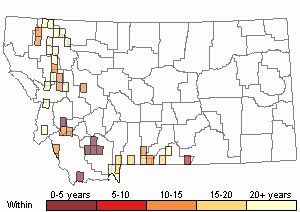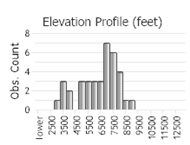View in other NatureServe Network Field Guides
NatureServe
Montana
Utah
Wyoming
Idaho
Wisconsin
British Columbia
South Carolina
Yukon
California
New York
A Ptychostomum Moss - Ptychostomum pseudotriquetrum
Other Names:
Bryum pseudotriquetrum
General Description
Plants: Acrocarpous (Vitt 1988). Growing in crowded patches of erect shoots, green with yellow or red tones, turning to russet with time. Stems mostly 20-40 mm tall, seldom to 60 mm (FNA 2014), occasionally few-branched (Crum & Anderson et al. 1981), with leaves a little more dense at the top of the stem, frequently with numerous long rhizoids, especially near the terminal ends of the stems (FNA 2014).
Leaves: Somewhat distantly spaced below, more dense above (Crum & Anderson et al. 1981), green, or green with yellow or red tones, turning a dull, rusty red over time, twisted and curved when dry, upright or spreading a little when wet, mostly 2-4 mm in length, egg-shaped, plane to faintly cupped, scarcely enlarged at the top of the stem (FNA 2014); apex acute and frequently with a stout tip (Crum & Anderson et al. 1981); base narrowly and strongly extending down the stem; margins tightly rolled back and under proximally, sometimes over half the leaf length, the border strong; costa extending slightly beyond the leaf tip (FNA 2014), red below to somewhat russet above (Crum & Anderson et al. 1981).
Leaf Cells: Border of 2-3 cell rows, unistratose; medial and upper laminal cells diamond-shaped (FNA 2014) to 6-sided (Crum & Anderson et al. 1981) with moderate to thick walls, 3:1 or shorter, narrower to as wide as the lower laminal cells; lower laminal cells quadrangular and short, 3:1 (FNA 2014).
Phenology
Fruit ripens spring through mid-autumn (FNA 2014).
Diagnostic Characteristics
The related Ptychostomum bimum is not as large as B. pseudotriquetrum, is synoicous rather than dioicous, and has less substantial decurrencies (FNA 2014).
Range Comments
North American Range
Throughout Canada and the United States; not present in subtropics or tropics (FNA 2014). Known in Montana from Carbon, Cascade, Fergus, Flathead, Gallatin, Glacier, Lake, Meagher, Missoula, Park, and Ravalli Counties (Elliott 2016).
Observations in Montana Natural Heritage Program Database
Number of Observations: 66
(Click on the following maps and charts to see full sized version)
Map Help and Descriptions
Relative Density

Recency



 (Observations spanning multiple months or years are excluded from time charts)
(Observations spanning multiple months or years are excluded from time charts)
Habitat
Mineral-rich, wet soil and humus, edges of wooded swamps, lakes, and sedge fens, occasionally on wet shelves and seeping bluffs, and edges of foliage mats on rocks (Crum & Anderson et al. 1981).
Reproductive Characteristics
Dioicous. Seta mostly 10-40 mm tall. Capsule somewhat long and egg-shaped (FNA 2014) to club-shaped, inclined to drooping (Crum & Anderson et al. 1981), 3-5 mm in length, brown, the opening yellow (FNA 2014), the neck occasionally the same length as the rest of the capsule (Crum & Anderson et al. 1981); peristome fully developed; exostome dentitions yellow below, transparent above, without pores on the center line; endostome divisions with egg-shaped openings; cilia tall and transversely ridged (FNA 2014).
Specialized vegetative reproduction sometimes occurring by brown, filiform gemmae produced in the leaf axils (FNA 2014).
References
- Literature Cited AboveLegend:
 View Online Publication
View Online Publication Crum, H.A. and L.E. Anderson. 1981. Mosses of Eastern North America. 2 volumes. Columbia University Press, New York. 1328 pp.
Crum, H.A. and L.E. Anderson. 1981. Mosses of Eastern North America. 2 volumes. Columbia University Press, New York. 1328 pp. Elliott, J.C. and A.K. Pipp. 2018. A Checklist of Montana Mosses (1880-2018). Updated 3 January, 2020. Montana Natural Heritage Program, Helena, Montana. 73 pp.
Elliott, J.C. and A.K. Pipp. 2018. A Checklist of Montana Mosses (1880-2018). Updated 3 January, 2020. Montana Natural Heritage Program, Helena, Montana. 73 pp. Flora of North America Editorial Committee, eds. 2014. Flora of North America North of Mexico. Volume 28. Bryophytes: Mosses, Part 2. Oxford University Press, Inc., NY. xxi + 702 pp.
Flora of North America Editorial Committee, eds. 2014. Flora of North America North of Mexico. Volume 28. Bryophytes: Mosses, Part 2. Oxford University Press, Inc., NY. xxi + 702 pp. Vitt, D. J. Marsh, and R. Bovey. 1988. Mosses, Lichens & Ferns of Northwest North America. Seattle, WA: University of Washington Press. 296 p.
Vitt, D. J. Marsh, and R. Bovey. 1988. Mosses, Lichens & Ferns of Northwest North America. Seattle, WA: University of Washington Press. 296 p.
- Additional ReferencesLegend:
 View Online Publication
View Online Publication
Do you know of a citation we're missing? Elliot, J. C. 1993. Second checklist of Montana mosses. Unpublished report. U.S. Forest Service, Region 1. Missoula, MT. 45 pp.
Elliot, J. C. 1993. Second checklist of Montana mosses. Unpublished report. U.S. Forest Service, Region 1. Missoula, MT. 45 pp. Flowers, S. 1973. Mosses: Utah and the West. Brigham Young University, Provo, Utah. 567 p.
Flowers, S. 1973. Mosses: Utah and the West. Brigham Young University, Provo, Utah. 567 p. Lawton, E. 1971. Keys for the Identification of the Mosses on the Pacific Northwest. Reprinted from 'Moss Flora of the Pacific Northwest'. Published as Supplement No. 2 of the Journal of the Hattori Botanical Laboratory. Nichinan, Miyazaki, Japan. 66 pp.
Lawton, E. 1971. Keys for the Identification of the Mosses on the Pacific Northwest. Reprinted from 'Moss Flora of the Pacific Northwest'. Published as Supplement No. 2 of the Journal of the Hattori Botanical Laboratory. Nichinan, Miyazaki, Japan. 66 pp. Lawton, E. 1971. Moss Flora of the Pacific Northwest. Hattori Botanical Laboratory. Japan: Yamabuki-cho, Shinjuku-ku, Tokyo. 362 pages plus appendices.
Lawton, E. 1971. Moss Flora of the Pacific Northwest. Hattori Botanical Laboratory. Japan: Yamabuki-cho, Shinjuku-ku, Tokyo. 362 pages plus appendices. Malcolm, B., N. Malcolm, J. Shevock, and D. Norris. 2009. California Mosses. Nelson, New Zealand: Micro-Optics Press. 430 pp.
Malcolm, B., N. Malcolm, J. Shevock, and D. Norris. 2009. California Mosses. Nelson, New Zealand: Micro-Optics Press. 430 pp. Smith, A.J.E. 1980. The Moss Flora of Britain and Ireland. Cambridge University Press, Cambridge. 705 pp.
Smith, A.J.E. 1980. The Moss Flora of Britain and Ireland. Cambridge University Press, Cambridge. 705 pp.
- Web Search Engines for Articles on "A Ptychostomum Moss"





